Do you know the difference between long off and silly mid-on? If not, then you’re in the right place! The fielding positions in cricket have a variety of different names, some of which sound quite strange! You’ll hear them mentioned all the time by the commentators when you’re watching a game, so it’s important that you get to know the difference between them all.
In this post I will take you through each fielding position and explain whereabouts on a cricket field they are, as well as giving you a few more details on the position such as what situations they are required in, how close they are to the bat, and the abilities that you’ll require if your captain chooses to put you in that position!
If you’re looking for a quick overview, the diagram below will give you a good idea of where each fielding position is on the field…
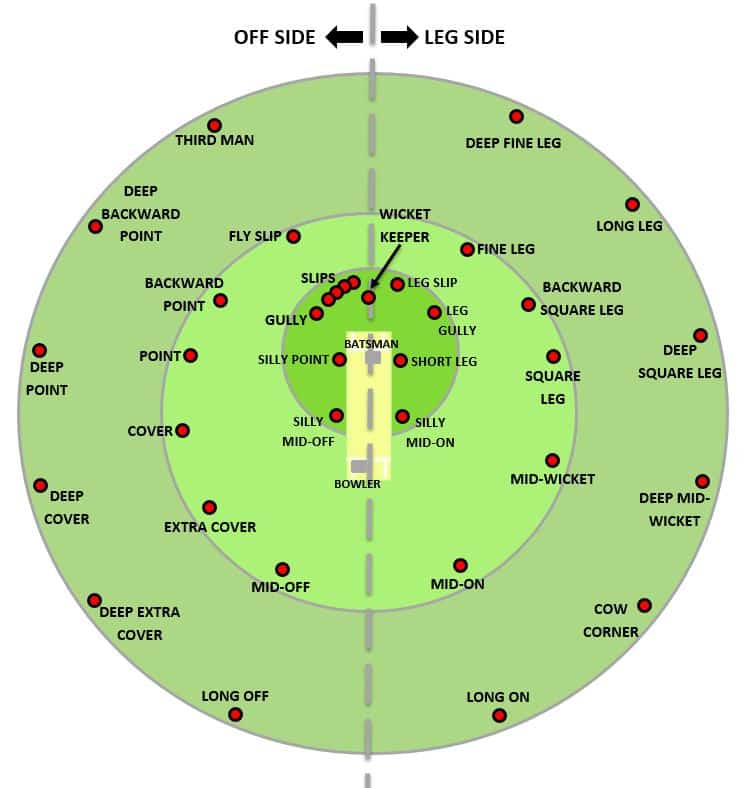
Before we get into the details of each position specifically, let’s run over the basic facts about the cricket field!
Basics Of The Cricket Field
In terms of fielding positions, I like to divide the cricket field into 3 parts:
- The Close Catching Infield – This area contains the fielders that are the closest to the batsman. Everyone inside this ring will be about 15 yards away or closer! These are often specialist catching positions, with a bit less of a focus on saving runs! If you look at the diagram of the cricket field I included above, the close catching infield is represented by the smallest circle in the centre of the diagram.
- The Inner Ring – This area contains the fielders that will usually be looking to stop the batsmen running singles. Fielders in this area will usually be somewhere up to 30 yards away from the batsman! If you’re fielding in the inner ring, make sure you’re getting yourself in a nice balanced position as the ball is bowled. You should be on your toes, ready to spring left or right in the direction of the ball if it is hit towards you. The inner ring is represented by the second smallest circle on the diagram above.
- The Outfield – This zone contains all the other areas right up until the boundary on all sides of the wicket. Fielders placed in this zone will be there primarily to stop the batsman hitting the ball for boundaries. The outfield is represented by the largest circle in the diagram above.
If you’re not sure which side of the field the off side and the leg side are, then it may be worth clicking this link to read my post where I break down the difference between the two. To keep it simple though, the off side of the batsman will be the side of the field they are facing when they’re in their batting stance. The leg side is opposite of this, therefore it is the side of the field that is behind them when they’re in their stance.
The Close Catching Infield
Wicket Keeper
This is the most important fielding position, and one that all teams have to fill! The wicket keeper stands behind the batsman, and is responsible for catching the ball in their gloves if the batsman edges, misses or leaves the ball. The distance between the wicket keeper and the batsman varies depending on the speed of the bowler. If a professional fast bowler is bowling, you’ll see most wicket keepers stand approximately 20 metres away from the batsman. If a spinner is bowling, the wicket keeper will move closer and stand behind the stumps. This is due to the difference in bounce achieved by the different types of bowlers.
Wicket keepers are usually very good athletes, with great levels of agility and hand-eye co-ordination. Due to the fact that bowlers don’t always bowl accurately, they are required to dive around a lot to catch the ball, and they are also responsible for catching incoming throws from the other fielders. When spinners are bowling, the fact that the keepers come closer to the stumps gives them even less margin for error. A top-class wicket keeper needs to be great at anticipating the amount of spin that the spinner is going to get, as well as great at noticing any variations that the spinners bowls. They are also responsible for catching the ball and ‘stumping’ the batsman if they leave the crease!
Wicket keepers fielding close to the stumps will often wear a helmet, whereas if they are standing a long way from the stumps, they may not choose to wear any head gear at all.
The Slips
The slips are another vital area on a cricket field. There are actually 4 main fielding positions within the slips: 1st slip, 2nd slip, 3rd slip and 4th slip. However, not all of these positions need to be used at the same time! Slip fielders will usually set their position based on where the wicket keeper is standing. On most professional teams, the wicket keeper will often be a little closer to the batsman than 1st slip is. You can see this in the diagram below! Fielders in the slips will also often stagger themselves diagonally so that 1st slip is stood further back than 2nd slip, and 2nd slip is stood further back than 3rd slip and so on. The reason that they stagger themselves in this way is so that they do not dive in to each other if the batsman edges a ball between them!
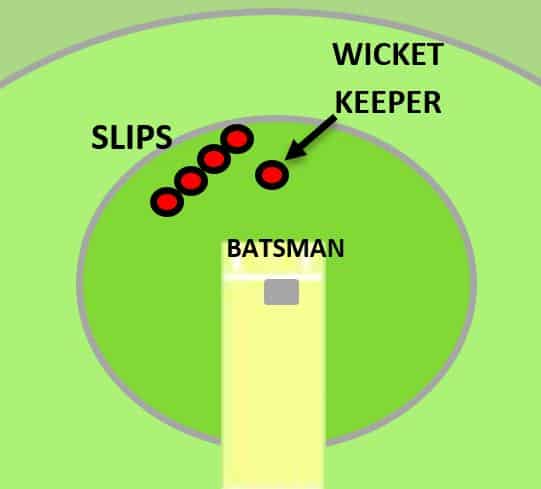
Slip fielders need to be able to concentrate for long periods of time. This is because balls are not hit in their direction that often! However, when a chance does come, the slip fielders have to be ready to take the catch! A lapse in concentration from a fielder in the slip region can cost the bowler a wicket! Catches come to slip fielders incredibly quickly, so they must be on their toes when the ball is delivered, poised to move from side to side. It also helps if they have good hand-eye co-ordination! If you’re looking to improve in these areas, then click here to read one of my posts that includes loads of different catching tips! It will definitely help you out if and give you plenty of new ways to practice!
The number of fielders that are fielding in the slip region at one time generally comes down to the choice of the captain and the bowler. If a fast bowler is bowling at the start of the innings, and the ball is swinging in the air, you may see all 3 slip positions being used, as there is a higher chance a catch may come to them. If there is less movement in the air, or if the batsmen are totally dominating the bowlers, captains may choose to remove all of the slip fielders and put them in more defensive positions elsewhere. When spin bowlers are bowling, it is rare to see more than one slip fielder being used.
Gully
The gully position is an extension to the line of slip fielders. So, a fielder who is in the gully position will be stood in front of the other slip fielders, but still remains on the same diagonal line as them. In some cases, there may be a slightly larger gap between the last slip fielder and the gully position than there is between each individual slip fielder. The diagram below shows the gully position and its relationship with the slip region!
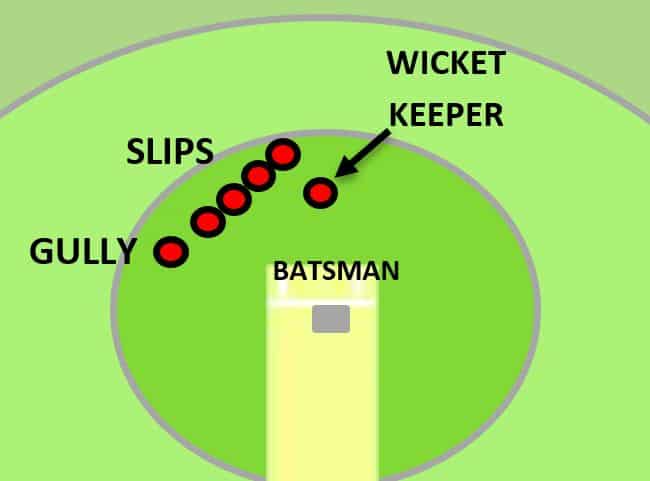
Here are a few scenarios where you may see the gully position being used:
- At the start of a match when the ball is swinging around
- After a wicket has been taken and a new batsman is at the crease
- When playing on a ‘slow pitch’ – Slow pitches mean the ball doesn’t come on to the bat as quickly, which may cause batsmen to push at the ball a bit harder. This can lead to edges travelling wider towards gully, rather than finer towards 1st slip!
- When the captain has a hunch – Sometimes a captain just feels like an edge is more likely to travel in the direction of gully rather than the slips!
- If a batsman has a history of being caught in the gully region
The skills that a fielder needs to field in the gully position are pretty much the same as those needed to field in the slips. A gully fielder needs to be agile, capable of moving to their left and right extremely quickly, and they also need good hand-eye co-ordination to catch the ball when it is flying towards them at high speed.
Leg Slip
The leg slip position is behind the wicket on the leg side of the batsman, and is essentially the opposite of the normal slip positions.
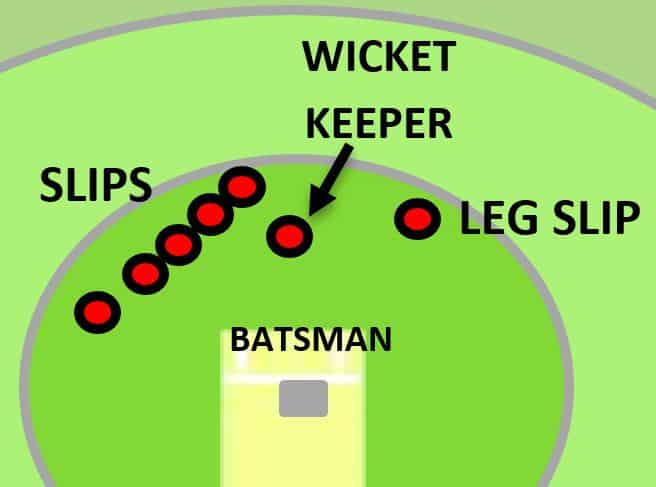
However, it is not used anywhere near as much as those positions! When the captain does decide to use the leg slip fielding position, it is extremely rare that you will see more than one fielder being there at a time! This is because:
- Leg slip is primarily a catching position, and not many batsmen get out caught in this area. Therefore, some teams will never use the position at all! Let alone having two fielders in there!
- The maximum number of fielders allowed behind square on the leg side is 2! So, it is unlikely that a fielding side will want to have 2 catching fielders close to the bat leg slip when they could choose to have one on the boundary at long leg/fine leg instead!
Captains will use the leg slip position if they feel that a batsman gets lazy with their glance shots into the leg side. If a batsman plays this shot lazily, they may only get a soft touch on the ball which could mean that it travels in the air towards leg slip. Using this kind of strategy to get a batsman out while a fast bowler is operating would generally be considered a last resort!
However, if a spinner is bowling, the leg slip position can be used to defend the paddle sweep shot. If the batsman chooses to sweep and gets a top edge on the shot while there is a leg slip in place, there is a high chance they may be out caught. In my opinion, this is a much more useful fielding position while spinners are bowling, especially spinners that primarily turn the ball towards the leg side of the batsman!
Fielders who are placed in this position will need to have high levels of agility and hand-eye co-ordination. The skillset required is incredibly similar to what is required of the normal slip and gully fielders! There is not much running around involved…but you may have the opportunity to take a sharp catch if you get lucky!
Leg Gully
The leg gully position is incredibly similar to the leg slip position, except that they will be stationed slightly wider on the leg side of the batsman. If you look at the diagram below, you’ll be able to see the difference between the two positions.
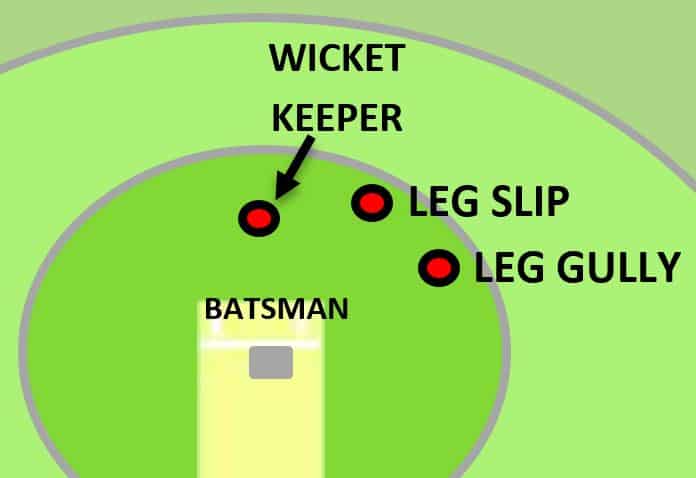
The two positions also have very similar uses. If you see a fielder in this position for a fast bowler, the fielding side will be aiming to trick the batsman into playing a loose shot when tucking the ball behind square on the leg side. A finer contact with the bat would take this shot in the direction of leg slip, while a slightly heavier contact may direct the ball towards leg gully! Leg gully may also be a good fielding position to use if you’re looking to attack the batsman with a barrage of short pitched bowling. If the batsman makes a mistake evading/playing the bouncer, the ball could hit their gloves and pop up to the fielder at leg gully.
Similar to the leg slip position, I feel it is best used as a way of dismissing batsman when they play the sweep shot. If the batsman fails to keep the ball on the ground, and does not get it high enough so that it clears the leg gully fielder you could dismiss them in this area!
If a chance does come their way, leg gully fielders will need to be alert and ready move quickly to their left or right to take the catch.
Silly Point
Silly point is a position very close to the batsman on the off side of the field. They should be standing in front of the batsman, at about a 45-degree angle. The silly point fielder should be standing around a metre away from the cricket pitch, and should make sure they do not tread on the cricket pitch while the bowler is going through their run up! The diagram below should clear up any confusion!
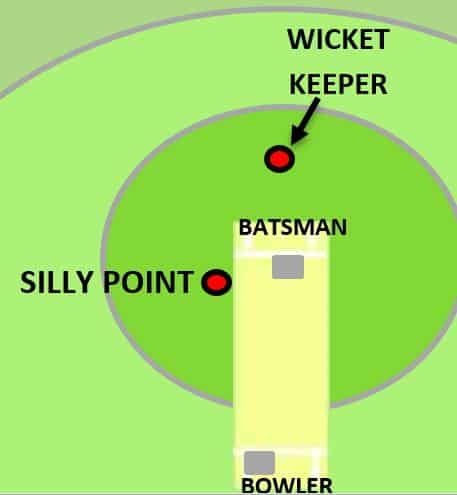
Silly point is an incredibly important position when spinners are bowling in longer formats of the game. If silly point is in the game, it is an aggressive choice by the fielding captain who is putting a lot of emphasis on taking wickets. Ideally, the fielding side will be looking for the batsman to misjudge the spin on the ball. If this happens, they could edge the ball on to their own pad, causing it to pop up in to the air towards silly point. They could also prod the ball towards silly point in the air when playing a defensive shot to the spinning ball!
You have to be an incredibly skilful and brave fielder to perform the silly point role effectively! Because of how close you are to the bat, it is a dangerous position and you will have to wear a helmet, a box (or cup), and shin guards at all times! You will need to have incredibly fast reflexes, and be ready to take very sharp catches. You will also need to be ready to take evasive action quickly if you see the batsman lining up an aggressive shot!
Silly Mid-Off
Silly mid-off is another fielding position that is quite close to the batsman on the off side of the field. This time, the fielder will be a lot straighter than the silly point position. Have a look at the diagram below to see the difference in the two positions!
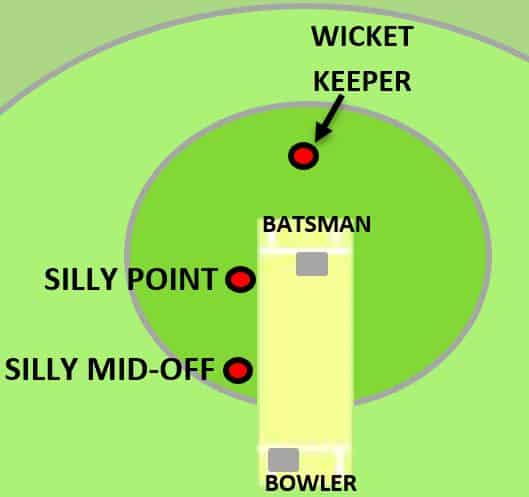
The idea behind the silly mid-off position is pretty much the same as silly point. It is an aggressive, close catching position that relies on the batsman making a mistake with their timing or stroke play in order for chances to be created. You’ll see it used more when spinners are bowling rather than fast bowlers!
Again, if you’re fielding here you’ll need to wear all the correct protective equipment (helmet, box/cup, and shin guards). You’ll also have to be incredibly alert. These positions close to the bat provide some of the most difficult catches in cricket. Only the fielders with the fastest reflexes and best hands will have success in these positions.
Short Leg
Short leg is pretty much the same position as silly point, except for the fact that it’s on the leg side of the batsman. The diagram below will show you the where the short leg position is!
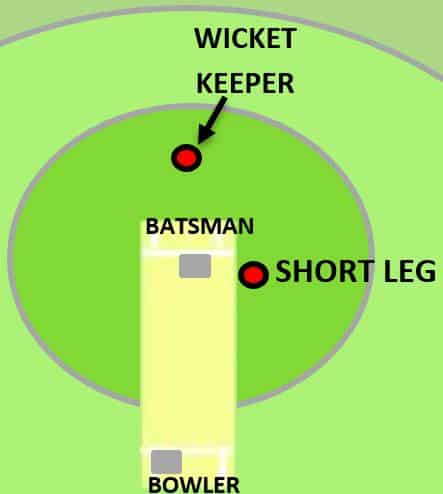
Short leg is also put in place to take catches when spin bowlers are operating, with the hope that the batsman will edge or mistime the ball in the direction of the fielder. You’ll see short leg used a lot when fast bowlers are bowling too. Certain batsmen cannot play the short ball well, and as a result they may get hit on the gloves a lot or fend the ball off in the direction of short leg. It is a very effective fielding position if you want to test a batsman out against the bouncer!
As with all these close fielding positions, it’s recommended that you wear all the protective gear, because the batsman can easily hit a powerful shot in your direction. Make sure you’re brave, ready to take those sharp chances, and ready to take evasive action if the batsman smacks the ball towards you!
Silly Mid-On
Silly mid-on is the last fielding position that is very close to the bat, and it is on the leg side, a lot straighter than short leg. Have a look at the diagram below to see what I mean.
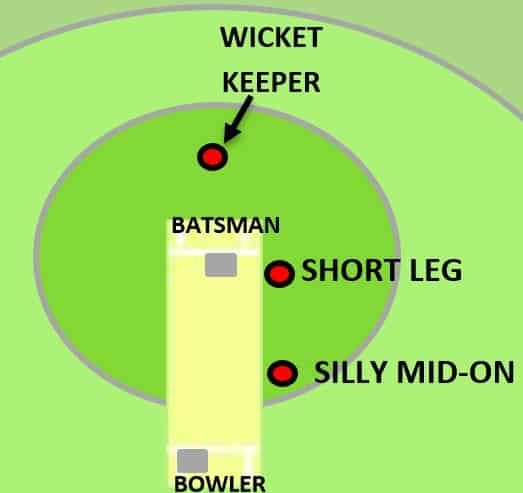
Captains will choose to use this fielding position for the same reasons as they would choose to use short leg, silly point and silly mid-off, which is to catch the ball when the batsman plays a bad shot.
Silly mid-on is another position you’ll need the protective equipment for, as well as being alert and prepared to take quick catches, and being ready to protect yourself if the ball is hit towards you forcefully.
The Inner Ring
Point
The point fielding position is square of the wicket on the off side of the batsman. How far away from the bat they choose to stand depends on the pace of the bowling. For example, if a professional fast bowler is operating, the point fielder should probably consider keeping a good distance between themselves and the batsman. If a spinner or a significantly slower bowler is bowling, the fielder may choose to bring themselves in a little closer. Often this decision will be made by the fielding captain. I’ve included the diagram below so you can see more clearly where the point fielder should be located!
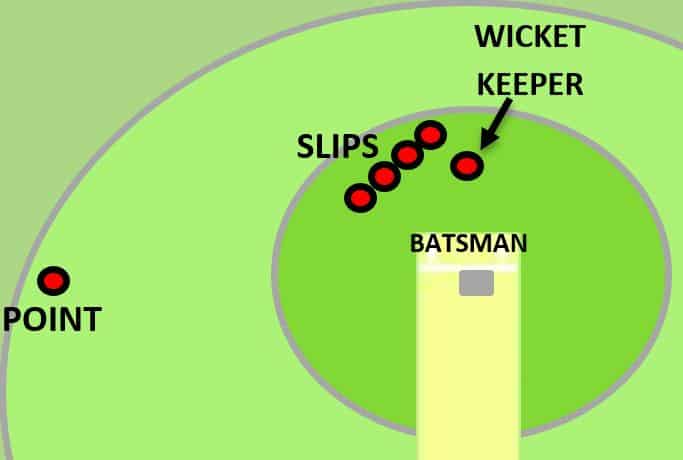
Most bowlers will be targeting the off stump of the batsman, and this means that if the batsman plays attacking shots to balls on this line, there is a high chance the ball could be coming to the fielder at point! As a result, a lot of cricket teams will choose to put their most athletic fielder in the point position.
The point fielder has to cover a lot of ground to both their left and right, often being required to run and dive to stop the ball before it goes past them. They are also required to put pressure on the batsmen if they hit the ball in their direction and try to run a quick single! Many batsmen will choose to play expansive square cut shots, meaning that the ball may fly past the point fielder in the air. This opens up opportunities to take some amazing catches if the fielder is athletic and skilled enough! Some of the best catches in cricket history have been taken in this position! Click this link to go to youtube and see one of my favourites!
This was probably my favourite place to field! If you can cover ground quickly, and you have the basics of ground fielding nailed, you always feel like you’re having an impact on the game when you’re in this position.
Backward Point
The backward point position is almost identical to the point position, except for the fact it is slightly behind square of the wicket on the off side! The diagram below will show you the relationship between the two positions.
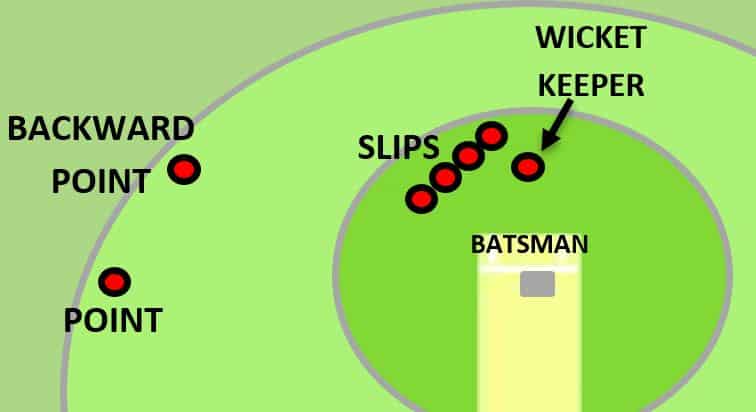
A captain may decide to have a fielder at backward point rather than point if a faster bowler is operating, or if there is a bit more pace and bounce in the pitch. These things will often lead to batsmen hitting cut shots slightly behind square if they choose to play that shot.
The role and the skillset needed to field in this position are exactly the same as I explained for the point position!
Mid-Off
The mid-off fielder should be positioned just a bit wider than straight on the off side of the field. Check the diagram below if you want to see the exact position!
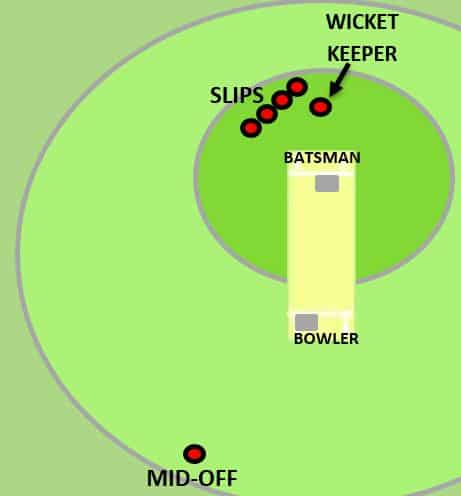
Fielders at mid-off are used to stop the batsman playing the drive towards the long-off boundary. They are positioned close enough to the bat that they can stop the batsmen taking a single if the ball is hit towards them. A lot of shots travel through this area of the field, so captains should make sure they post a competent fielder in this position! They will often have to move quickly to cover any shots that are hit straight down the ground, or between themselves and the cover fielder. It’s another position that might require a lot of diving around!
Captains will often choose to position themselves here as it is close enough to be able to speak to the bowler very easily, as well as direct the fielders around the bat to their correct positions.
Cover
Fielding at cover is another incredibly important job, due to the amount of shots that get hit into this area. The cover fielding position is just in front of square on the off side, and the fielder will usually stand on the edge of the inner circle. The cover position lies between point and extra cover. Check the diagram below to see the position on the cricket pitch!

Many bowlers try to encourage the batsman to drive the ball so that they will edge it towards the fielders in the slips. However, if the batsman plays the shot well, there’s a high chance the ball will be coming towards the cover fielder at a high speed. Fielding in this position will mean you have plenty of run out opportunities, as well as opportunities to stop boundaries by diving to your left and right to stop the batsman’s shots before they pass you! Speed, agility and hand-eye co-ordination are vital in this position too, as they are for most of the inner ring fielding positions!
Some captains will choose to leave the cover position empty, because seeing this big gap in the field encourages the batsmen to drive the ball. Sometimes this risk pays off for the fielding team, and sometimes it doesn’t. By taking this option, the fielding captain is basically hoping the batsman is beaten by the bowler early, and will edge the ball to the waiting wicket keeper or slips.
Extra Cover
Extra cover is incredibly similar to the cover position, except for the fact that the fielder should be positioned a little straighter. Check out the diagram below to see the difference between the two positions.
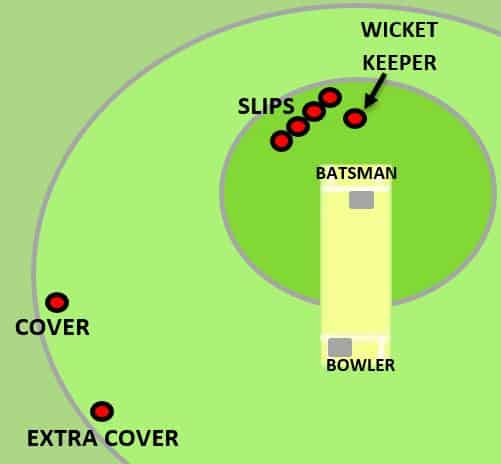
The choice between using a cover fielder or an extra cover fielder (or both) comes down to the decision of the captain and the bowler. They will usually assess the strengths and weaknesses of the batsman, the game situation, and the overhead/pitch conditions when making these decisions. Extra cover is another high traffic area for cricket balls and placing fielders in this position will give them a big chance to make an impact on the game!
The skills and roles of the fielder used in this position are largely the same as the one for the cover position!
Mid-On
Mid-on is basically the same position as mid-off, except it is on the leg side of the field. The diagram below will show you exactly where the mid-on fielder should be located!
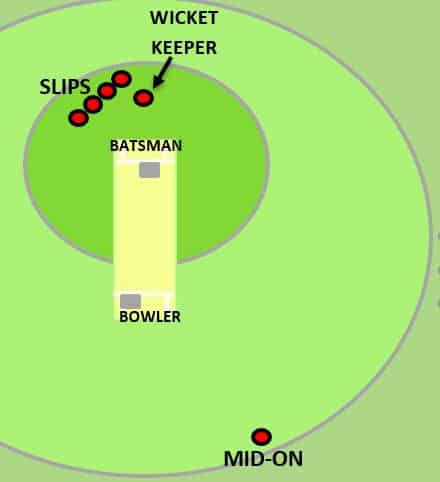
The role of the mid-on fielder is also very similar to mid-off. They will be required to stop drives in to the leg side, and will also have to cover the gap between themselves and mid-wicket. They should be trying to pressure the batsmen if they try to take a single. Therefore, they’ll need to be relatively quick across the ground!
This is another good position for captains to place themselves in!
Square Leg
The square leg fielder is located square of the wicket on the leg side of the field. If you need a clue to where this position is during a game, look for the umpire who is not at the bowler’s end of the pitch. This umpire will often be standing in the square leg position; therefore, you should try to position yourself near them! The diagram below will show you whereabouts this position is located!
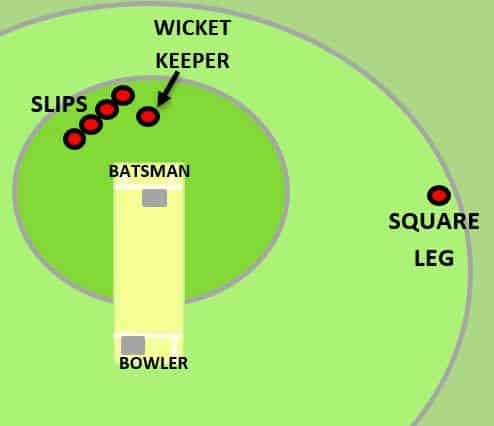
The square leg fielder will have a variety of roles. There is a large gap between them and the mid-wicket fielder, so they will have to be quick on their feet to stop the single if the batsman chooses to knock the ball anywhere into this gap! The square leg fielder is also vitally important when batsmen choose to play the hook/pull shots to fast bowlers, or the sweep shot to a spinner. These kinds of shots will come towards the square leg fielder at a variety of speeds, directions and heights, so they will have to make sure they are on their toes and prepared for every delivery as the bowler runs in to bowl!
Similarly to the point position, captains should try to get one of their most athletic fielders stationed at square leg. They often have to cover a lot of ground on the leg side, especially if there is no mid-wicket or fine leg fielder in place!
Backward Square Leg
The backward square leg fielding position is just behind square on the leg side of the field. It’s almost identical to the square leg position, except it is a few metres further behind the batsman. This diagram will show you the difference between the two positions:
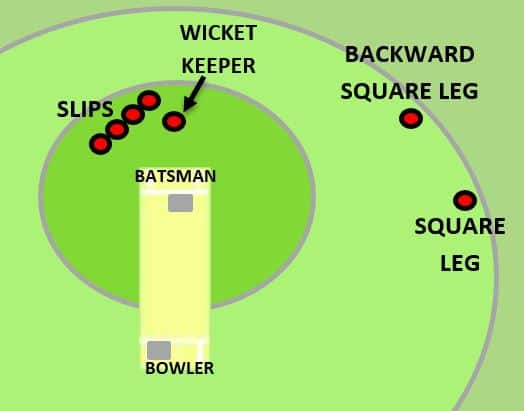
A fielder in this position will require the same skill set and athletic profile as the square leg fielder. Their primary concern will be to cut off the single, while doing their best to cover ground to their left and right to stop the ball travelling into the outfield. Batsmen will primarily be playing aggressive shots towards this area of the field, such as the hook, the pull and the sweep to the spinners. The square leg fielder should be prepared for these and be on their toes at the point the bowler releases the ball!
Mid-Wicket
Mid-wicket is a vital position in front of square on the leg side of the batsman. The mid-wicket fielder should be standing roughly on the edge of the inner circle, close enough to stop the single. Check the diagram below to see where mid-wicket fielders should be standing!
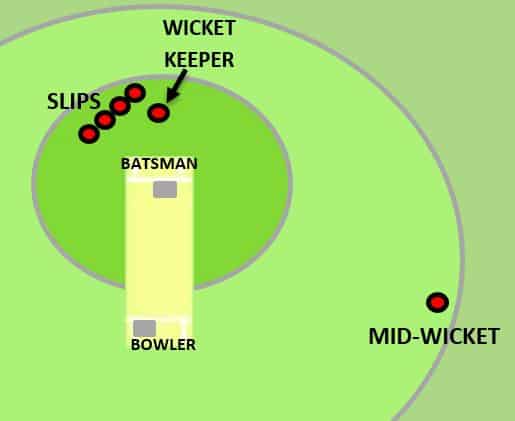
Mid-wicket is such an important position because a lot of power shots that are played by batsmen tend to go towards this area. A mid-wicket fielder should be covering the space between square leg and mid-on, requiring them to be pretty athletic. This fielder will have the opportunity to save the bowling side a lot of runs, by pressurising the batsmen when they try to run singles, and also moving laterally to cut off the boundary shots if there is no fielder deep behind them.
There is a high chance that catches will come to you if you’re in this position. As I already mentioned, a majority of batsmen like to play power shots in this area, and if they mistime one they may offer up a catch!
Fine Leg
The fine leg fielding position is behind square on the leg side of the field, and it can also be referred to as short fine leg due to how close it is to the batsman. The fielder should position themselves at a tad less than a 45-degree angle to the batsman, and should be on the edge of the inner circle of the field. If any of that was confusing, the following diagram should make everything clear:
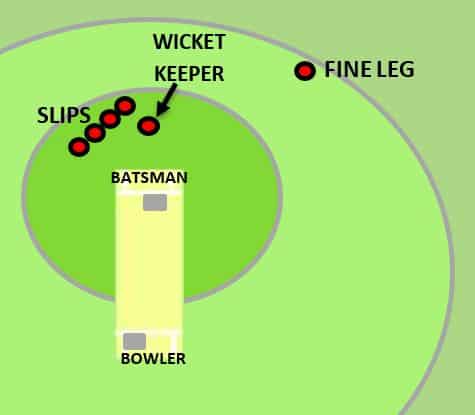
(Short) fine leg is mainly put in place to stop 2 things:
- The batsman tucking the ball off their hip behind square on the leg side of the field while a fast bowler is bowling
- The batsman playing the sweep shot to a spinner
In an ideal scenario, if the batsman plays either of the two shots listed above, the fielder in this position will be able to gather the ball quickly and stop them taking a single. The downside of the position is that the batsman only has to direct the ball a few yards either side of the fielder and they will probably pick up a boundary. It is very rare that the fielding side will choose to have a deep fielder on the boundary behind (short) fine leg!
It always helps if you can anticipate the shot the batsman is going to play when you’re fielding in this position. If you see them getting down to play a sweep shot, you can prepare yourself to move very quickly. You will also have to be quick across the ground, and good at gathering the ball cleanly and throwing it in to the wicket keeper. If you’re in this position, there’s a good chance you’ll be doing a lot of sprinting after the ball as it travels towards the boundary!
Fly Slip
The fly slip position is located on the off side of the field, and is slightly deeper than the normal slip region. In fact, the fly slip fielder will often be as deep as the edge of the inner circle. You may also hear people refer to this position as ‘short third man’. Check the diagram below to see the position in relation to the normal slip fielders!
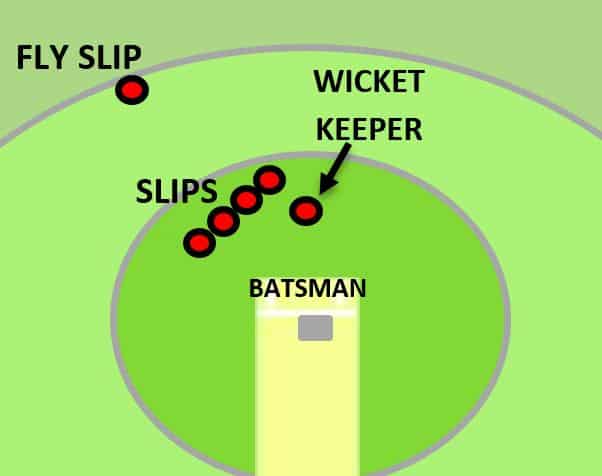
Many batsmen will try to glance the ball through the fly slip area when there are no normal slips in place, and this is usually why this fielder will be used. Basically, it is a more defensive alternative to the normal slip fielder! As it is positioned a bit deeper, it gives you a better chance to cut off the single and the boundary. This position will usually not be used if there are normal slip fielders already in place, or if there is a third man positioned on the boundary behind them.
If you’re fielding at fly slip, be prepared to do a lot of running around and chasing the ball towards the boundary. This is a high traffic area as many batsmen love to run the ball off the face of the bat into this area. It is an easy shot for them to play in order to get off strike. Your task will be to close on the ball quickly, and pressure the single if the ball is in your area. If the ball passes you, you will be expected to chase it down and hopefully prevent a boundary!
The Outfield
Third Man
Third man is another position that lies on the boundary, behind square on the off side of the field. The position should be in line with where the slip fielders are or would be, which is basically just a little bit finer than a 45-degree angle to the batsman. The picture below should explain what I’m talking about!
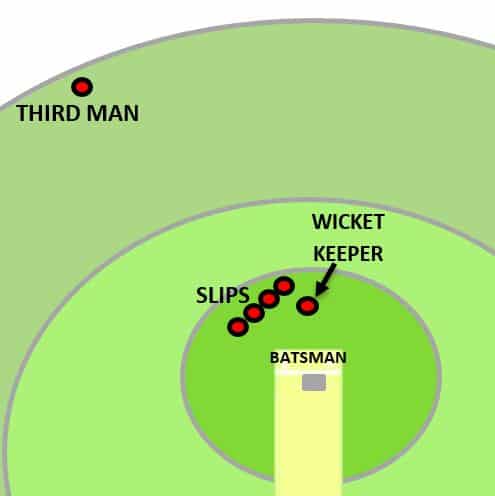
If there are no slip fielders in place, you’ll see this position used a lot. That makes it more suitable for limited overs matches where the slip fielders aren’t used as much! In test matches and longer formats of cricket, slip fielders are used more often, which often removes the popularity of the third man position.
Batsmen may try to run the ball off the face of the bat towards this area, or may try to uppercut the ball in the air over your head. These are just a couple of things you’ll have to look out for if you’re fielding in this position.
Deep Point
Deep point is the position that lies on the boundary, exactly square of the wicket on the off side. This can be seen in the following diagram!
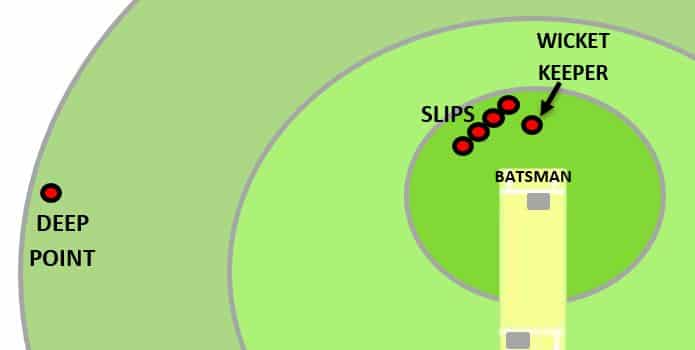
This is a defensive position, and as such there won’t be many catches to take when you’re out there! Your main role will be to cover the boundary edge and stop the batsman playing square cut shots for 4.
Deep Backward Point
Deep backward point is a position on the boundary that is just slightly behind square on the off side of the field. It is a relatively similar position to deep point, apart from the extra 10 or so metres that you will have moved behind square! This diagram should show you the difference in the two positions!
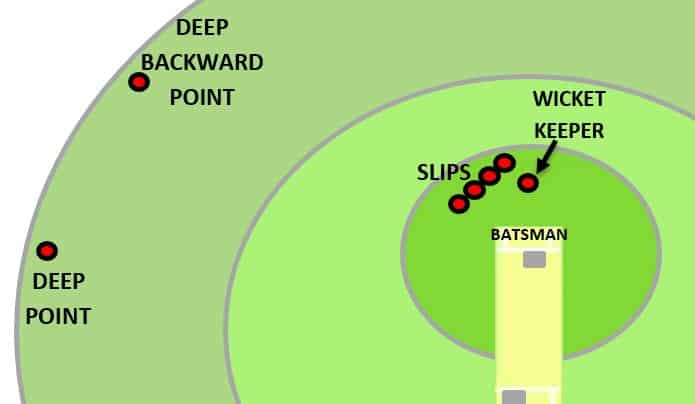
The captain may choose to use a deep backward point rather than a deep point if there is a little more pace in the pitch, or if the batsman is playing the ball very late. These things mean that the ball will be more likely to travel behind square! Your primary role in this position will be to stop any square cut shots going for 4!
Deep Cover
Deep cover is another boundary dwelling position that lies just in front of square on the off side of the wicket! The following diagram shows the position clearly!
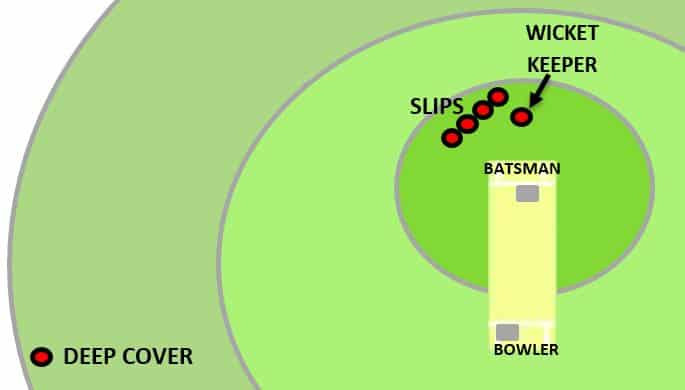
Deep cover is a defensive position that is used when the batsmen are striking the ball particularly well through the covers. If there isn’t a lot of movement in the air for the bowler, the batsmen will be more likely to drive through the off side. Some captains will choose to defend this area with a cover fielder, and some may wish to put in a deep cover instead for extra protection! Your role in this position will be to cut off the boundaries and cover a lot of ground to your left and right.
Deep Extra Cover
Deep extra cover is just a little bit further in front of square than the deep cover position! The diagram below will show you the difference between both positions!
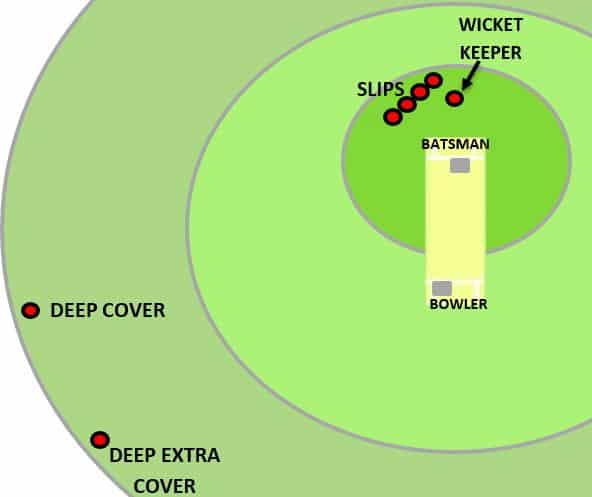
The goals of this position are very similar to deep cover and will require the fielder to be wary of the same things. It is a defensive field placement that is used to stop cover drives going for boundaries. Be prepared to do quite a bit of sprinting around the boundary edge if you get placed here!
Long Off
The long off position is just wide of straight on the off side of the field. It is also on the boundary edge like most of these outfield positions! Have a look at the diagram below to see it properly!
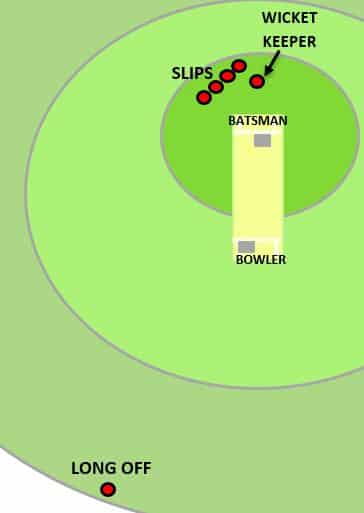
This position is used a lot in cricket, because there are a lot of shots the batsman can play into this area. If the bowler is bowling full and straight, there is a good chance that a lot of the shots played by the batsman will end up in this position. It’s also an area of the field where batsmen will try to play aerial shots, especially against spin bowlers!
If you’re fielding in this position, your job will be to cut off the boundaries and take any catches that come your way! This is pretty much the same for all boundary fielders if I’m honest!
Deep Fine Leg
The deep fine leg fielder should be positioned on the boundary behind square on the leg side. A good way to think about it is to imagine yourself at a 45-angle to the batsman, and then walk a few metres finer than this. If you’re confused have a look at the diagram below!
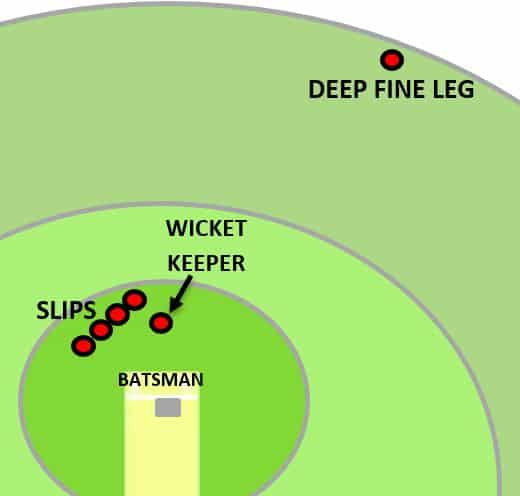
This is one of the massively popular boundary positions. You’ll regularly see a fielder here in test matches and shorter formats of the game! Batsmen will often target this area when the bowler strays down the leg side with their deliveries, and as a result a lot of runs are scored here! If you’re in this position, you’ll have quite a bit of ground to cover to your left and right depending on whether the batsman hits the ball fine or square. You don’t have to be a hugely skilled fielder to be in this position (although I would always recommend it!)
This fielding position can also be referred to as ‘fine leg’, so be aware of that if you hear it from a commentator or your captain!
Long Leg
Long leg is another fielding position behind square on the leg side that is slightly squarer than deep fine leg. The long leg fielder will have to cover the gap between deep fine leg and deep square leg. The fielder should be standing at around a 60-degree angle to the batsman! Check out the diagram below to see what I mean:
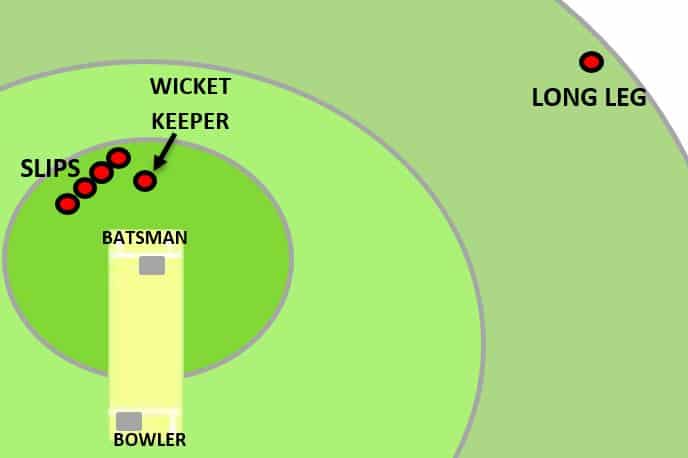
The main responsibility of the long leg fielder is to patrol the boundary behind square on the leg side and stop any shots near them going for 4. Captains will usually only have one fielder on the boundary behind square on the leg side, so they’ll have to choose whether to position them closer to deep fine leg or long leg.
Deep Square Leg
The deep square leg fielder should be on the boundary, square of the wicket on the leg side of the field. This is shown in the following diagram!
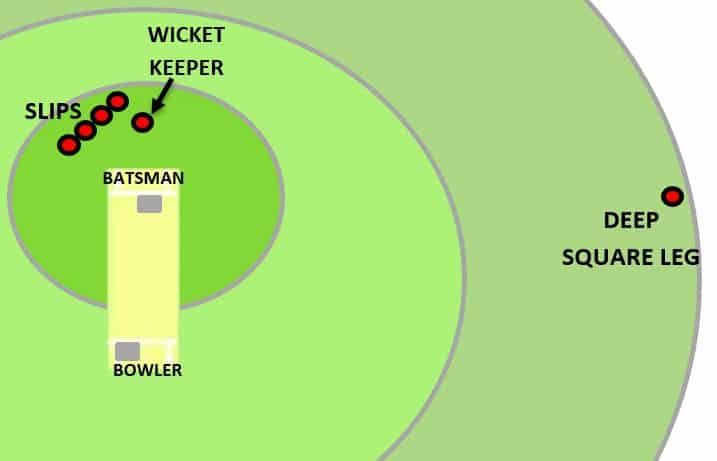
The fielder at square leg is there to protect the boundary, and stop any shots the batsman hits towards them from going for 4. This is a position that is used a lot because of the amount of times the hook and the pull shot are used by batsmen. If a batsman uses either of these shots there’s a high chance the ball will travel in the direction of the deep square leg fielder.
Some fielding captains will put a fielder out at deep square leg to bluff the batsman into thinking that they’re about to receive a short ball from the bowler. When the batsman is hanging back expecting the short ball, the bowler could choose to fire in a yorker at the batsman’s feet, giving them more chance of getting a wicket while the batsman is distracted! Fielding captains can also put a few fielders on the boundary on the leg side before bowling a barrage of short balls at a batsman to test their technique!
Deep Mid-Wicket
Deep mid-wicket is another incredibly important position on the boundary on the leg side of the field. It is located just slightly in front of square! Check this diagram to see exactly where it is…
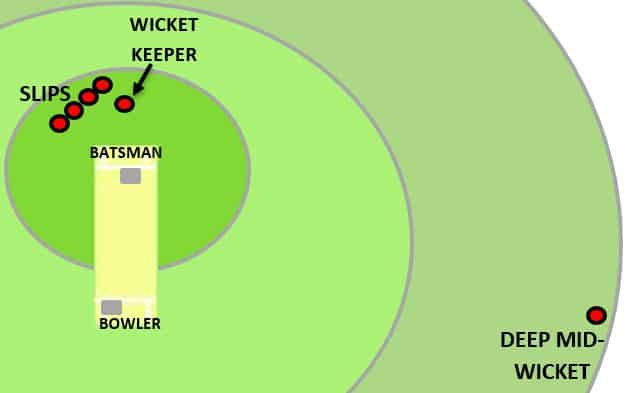
This position is regularly used in shorter formats of the game like T20 and ODI matches because the majority of batsmen will look to play their most aggressive shots towards this area. This means that during critical stages of a one day game, such as the end of the innings, cricket teams should make sure that they have one of their most skilful fielders in this position. As always with the boundary fielders, their main responsibility will be to try and cut off any shots from going for 4!
The deep mid-wicket position gives a fielder great chances to make incredible catches too! If you want some inspiration, check out this video of the catch Ben Stokes recently made while he was fielding at deep mid-wicket in the world cup! It’s one of the greatest catches in cricket history!
Cow Corner
I know what you’re thinking, and yes, cow corner is a very strange name for a place on a cricket field! Everybody seems to think that when they first hear it mentioned!
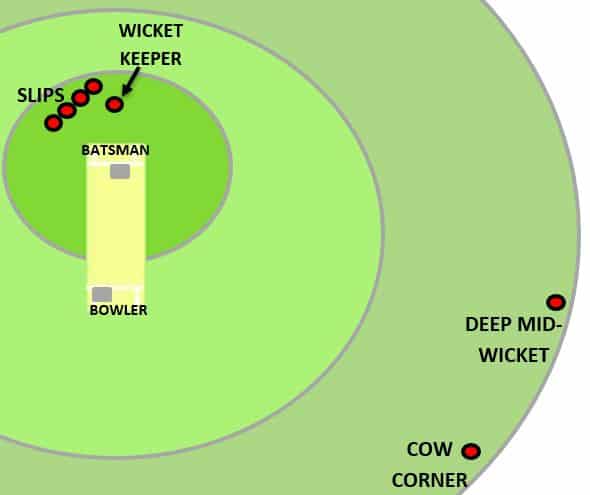
Cow corner is another fielding position on the boundary in front of square on the leg side of the field. The cow corner fielder should be a little bit straighter than the deep mid-wicket fielding position. Check this diagram to see how these positions are linked:
The responsibilities for a fielder at cow corner are not really different to any of the other boundary based fielders I’ve taken you through. The main difficulty will be covering ground to your left and right and cutting off boundaries, as well as taking the occasional high catch when a batsman mistimes the ball!
Because the deep mid-wicket and cow corner fielding positions are very similar, a captain will have to make a judgement call on whether to have fielders in both positions, or just one of them!
Long On
Long on is the final boundary based fielding position on the leg side of the batsman! If you imagine a line down the middle of the cricket pitch, then the long on position would be about 5-10 metres to the leg side of that line! You can see this in my diagram below!
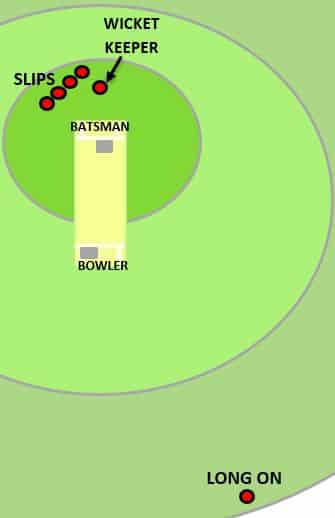
Long on fielders will be deployed as a run saving option primarily, and as a deterrent to any batsmen that are looking to hit sixes straight down the ground! They may have to cover a lot of ground further into the leg side and cut off any shots that are hit towards the boundary by the batsman. They may also have to cover space directly down the ground!
Fielding captains will often use positions like long on and long off before telling a fast bowler to bowl full and straight at the batsman’s stumps. This type of bowling means it is difficult for the batsman to hit the ball anywhere but straight down the ground! With these two fielders in place, the maximum amount of runs they would get for that type of shot is 1! This is an effective strategy at the end of a one-day innings!

